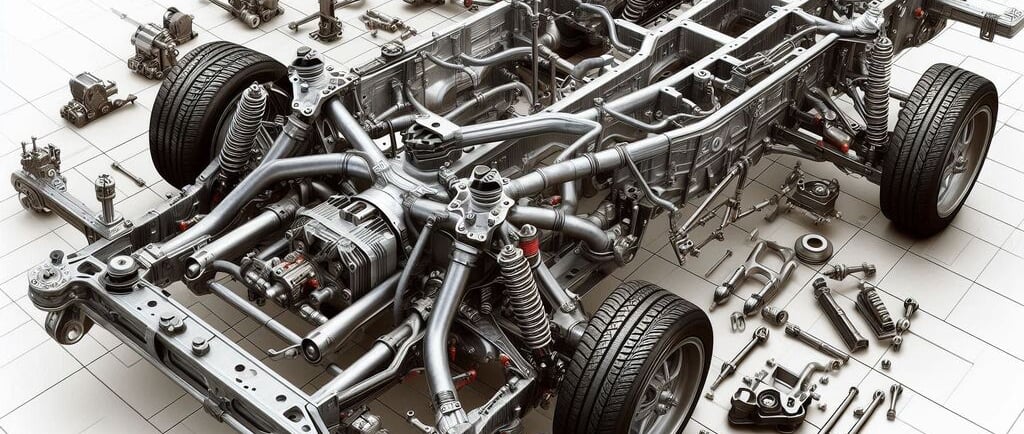Crossmembers: Structural support bars for the chassis.
When you think about vehicle safety and stability, you might immediately picture airbags, brakes, or seatbelts.
CHASSIS AND FRAME PARTS
11/13/20244 min read


Crossmembers: The Essential Structural Support Bars for Your Vehicle’s Chassis
When you think about vehicle safety and stability, you might immediately picture airbags, brakes, or seatbelts. But what about the crossmembers? These often-overlooked components are essential structural support bars within the vehicle’s chassis. Crossmembers play a crucial role in enhancing the durability and stability of a car, truck, or SUV, providing a solid foundation and protecting against various stresses.
In this article, we’ll explore what crossmembers are, why they’re so essential to vehicle performance and safety, the different types available, and how to ensure they stay in good condition. Whether you’re a car enthusiast or a casual driver, understanding the importance of crossmembers can help you appreciate the unseen strength in your vehicle’s structure.
What Are Crossmembers?
Crossmembers are structural support bars that run across the underside of a vehicle’s chassis. These bars connect the two sides of the frame and help distribute weight, resist bending, and reinforce the overall structure. By providing this support, crossmembers prevent the chassis from twisting and absorbing the forces encountered during driving, cornering, and even collisions.
Key Functions of Crossmembers
Stabilizing the Chassis: Crossmembers add rigidity to the vehicle’s frame, improving handling and safety.
Weight Distribution: These bars help spread the weight of the vehicle evenly, preventing structural strain.
Impact Resistance: Crossmembers can absorb and distribute impact forces in a collision, helping protect occupants.
Without crossmembers, your vehicle would be far more prone to structural stress, leading to potential issues with handling, stability, and even safety.
Types of Crossmembers
Not all crossmembers are created equal; different types serve specific functions, depending on the vehicle’s design and intended use. Here are some common types of crossmembers:
1. Front Crossmembers
Front crossmembers are positioned near the front of the vehicle’s chassis, typically supporting the engine and transmission. These crossmembers also serve as mounting points for the engine and help to absorb frontal impact forces in a collision.
Benefits: Provides a strong base for engine placement and absorbs impact forces in case of front-end collisions.
Example: Think of a truck that hauls heavy loads; the front crossmember adds critical strength to handle the engine’s weight and the demands of tough driving conditions.
2. Rear Crossmembers
Rear crossmembers are located at the back of the chassis, often providing mounting points for the suspension system. They help maintain rear-end stability, especially when the vehicle is heavily loaded or towing.
Benefits: Reinforces the back end for load-bearing, improves stability in towing situations.
Example: SUVs and pickup trucks that regularly tow trailers rely heavily on rear crossmembers to maintain control and stability.
3. Center Crossmembers
Center crossmembers, located in the middle of the chassis, connect the left and right sides of the frame, helping to prevent twisting during cornering or when driving over uneven terrain. They also contribute to the overall structural integrity of the vehicle.
Benefits: Adds rigidity to the vehicle’s structure, enhancing handling and performance on rough roads.
Example: In a sports car, the center crossmember helps maintain the vehicle’s stability during sharp turns and high-speed maneuvers.
Each type of crossmember contributes to the overall strength and stability of the vehicle, ensuring a safer and smoother ride.
Why Are Crossmembers So Important?
Crossmembers provide essential structural integrity, especially for heavy-duty vehicles or those used in rough conditions. Here are some reasons why crossmembers are key to vehicle health and performance:
Improved Handling and Stability: Crossmembers keep the chassis aligned and reduce twisting, especially during high-speed maneuvers or when carrying heavy loads. This enhances stability and makes driving more predictable and comfortable.
Protection During Collisions: In the event of an accident, crossmembers help absorb and distribute impact forces, potentially reducing damage to the frame and protecting the vehicle’s occupants.
Increased Durability: By reducing stress on the chassis, crossmembers prevent wear and tear on the frame. This is particularly important for off-road vehicles or those carrying heavy loads, as they endure more structural strain than typical passenger cars.
Maintaining Crossmembers: Tips for Long-Term Performance
Keeping your crossmembers in good shape is essential for the overall health of your vehicle. Here are some practical tips:
1. Regular Inspections
Crossmembers are located on the underside of your vehicle, making them susceptible to rust, corrosion, and other damage. Regular inspections—at least twice a year—can help you identify any issues before they worsen.
Tip: During routine maintenance, ask your mechanic to inspect the crossmembers for signs of damage, rust, or corrosion.
2. Rust Prevention
Rust is a common issue, especially for crossmembers, due to their exposure to moisture, salt, and road debris. Applying an anti-rust coating or rust-proofing treatment can help protect these essential support bars.
Tip: Rinse your car’s undercarriage periodically, especially in winter or if you live in an area where salt is used on the roads.
3. Prompt Repairs
If you notice any issues, such as a strange noise or handling issues, have your crossmembers checked immediately. Ignoring minor problems can lead to larger, costlier repairs and even impact the safety of your vehicle.
Common Crossmember Issues and How to Spot Them
Crossmembers are built to last, but they can face problems over time. Here are some common issues:
Rust and Corrosion: Crossmembers often rust due to exposure to moisture and salt. This can weaken the frame.
Cracks or Bends: Physical damage from accidents or rough terrain can cause cracks or bends, reducing the crossmember’s strength.
Loose Connections: Sometimes, bolts holding the crossmember in place can loosen, which affects stability.
Signs of Crossmember Issues
Unusual Noises: Clunks or rattles from the undercarriage can indicate crossmember damage.
Poor Handling: Difficulty with steering or unusual handling may point to a compromised crossmember.
Visible Rust: Regularly check the underside of your vehicle; rust is a sign that crossmembers may be compromised.
Conclusion: Crossmembers – The Unsung Heroes of Vehicle Stability
Crossmembers are the silent protectors of your vehicle, providing stability, safety, and structural integrity. Keeping them in good shape is essential for your vehicle’s health and your own safety on the road. By regularly inspecting, rust-proofing, and addressing any issues early on, you can ensure that these support bars continue to perform at their best.



